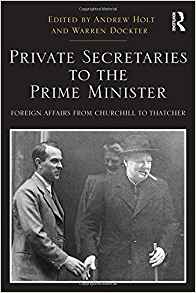
Finest Hour 178
Books, Arts, & Curiosities – Behind the Scenes

March 18, 2018
Finest Hour 178, Fall 2018
Page 49
Review by John Campbell
Andrew Holt and Warren Dockter, eds., Private Secretaries to the Prime Minister: Foreign Affairs from Churchill to Thatcher, Routledge, 2017, 213 pages. ISBN 978–1409441809
John Campbell’s books include major biographies of Edward Heath, Margaret Thatcher, and Roy Jenkins.
Compared to the White House or most other national centres of government, Number Ten Downing Street has always been an almost laughably small operation. Until quite recently the British Prime Minister was served by the Cabinet Secretary and a principal private secretary, plus just four or five subordinate private secretaries—youngish (that is, in their early forties) high-fliers destined to go on to senior positions within the civil service. The most senior, usually seconded from the Foreign Office, normally for no more than three years, dealt specifically with foreign affairs. Holders of this sensitive job were required to tread a fine line between loyalty to the Prime Minister on the one hand and civil service neutrality on the other. Some held strong views of their own which they pressed upon the Prime Minister, and sometimes acted independently on his behalf; others saw their role simply as smoothing the conduct of business between Downing Street and the Foreign Office. This arrangement survived, with varying degrees of intimacy and influence, from Churchill’s day to the early years of Mrs Thatcher, until she tested the system to destruction by allowing her third foreign affairs secretary, Charles Powell, to outgrow his role, refusing to let him move on as convention required, so that by the time of her fall he was virtually acting as deputy Prime Minister.

2024 International Churchill Conference
Unfortunately Powell does not feature in this book, which ends with his appointment in 1984, though he does contribute a typically elegant introduction describing some of his own experiences. Instead it comprises eight case studies by mainly British academics examining the relationship between successive Prime Ministers and the thirteen foreign affairs secretaries who temporarily served them. A concluding overview by Anthony Seldon seeks to analyse the differing relationships but rather confusingly widens the focus, first by including the principal private secretaries as well, and then by bringing the story up to date with the different structures tried out since Thatcher by John Major, Tony Blair, and David Cameron.
Seldon distinguishes three types of private secretary: those who were so closely identified with their Prime Minister that they overstepped civil service conventions; others who were influential but stayed within the conventions; and a third group who were merely correct and not very influential. Epitomising the first category was Jock Colville, joint principal private secretary to Churchill after his return to office in 1951. With Churchill in his last phase, the boundary between private and official roles was practically non-existent. Colville, as Warren Dockter (co-editor of the book) writes in the opening essay, was used on the one hand as a “secret diplomat,” attempting among other things to set up Churchill’s longed-for summit with the Russians after Stalin’s death, behind the back of the Foreign Secretary Anthony Eden; and on the other as the “Churchill family therapist,” playing endless games of bezique with Winston— while recording it all for posterity in his diary.
The next most influential were probably Philip de Zulueta under Harold Macmillan (1957–63), who (like Powell with Thatcher) stayed in post for twice the normal tenure and played an important part in turning Macmillan’s mind towards applying to join the European Common Market; and Michael Palliser (1966–69), who likewise helped steer Harold Wilson away from his initial commitment to maintaining Britain’s global role towards making a second attempt to join Europe. By contrast, Edward Heath’s two foreign affairs secretaries, Peter Moon (1970–72) and Thomas Bridges (1972–74), had much less to do with advancing Heath’s finally successful application: Heath leaned much more on his principal private secretary, Robert Armstrong. Jim Callaghan similarly relied far more on Ken Stowe and Bernard Donoughue (head of the Downing Street Policy Unit) than on his two foreign affairs secretaries Patrick Wright (1974–77) and Bryan Cartledge (1977–79), though both were able men and ended their careers as head of the Foreign Office and ambassador to Moscow respectively.
The problem with this book is that it depends almost entirely on the sources available, which are variable and often scarce. As one of the most recent holders of the post (Tom Fletcher, 2008–11) concludes in a foreword, “the Private Secretaries who are now best remembered are those who wrote most down.” Some—notably Colville—kept diaries. Others wrote serious briefings and memoranda to their Prime Minister, which can be seen to have influenced policy. But others left almost no trace in the archives. For instance, Nick Thomas, the author of the essay on Moon and Bridges, has done his best to piece together glimpses of their input by following a paper trail of drafts and redrafted documents, but even he admits that “the rare occasions when direct influence can be detected can hardly be called earth-shattering.” The result is a somewhat unsatisfactory compilation, which will be of interest only to the most dedicated students of British government. As Churchill famously said of a disappointing pudding, it lacks a compelling theme.
Subscribe
WANT MORE?
Get the Churchill Bulletin delivered to your inbox once a month.


